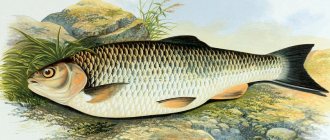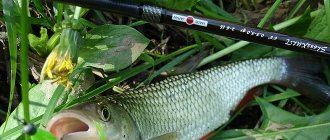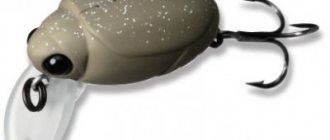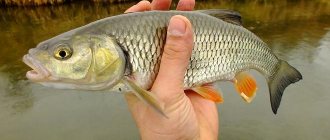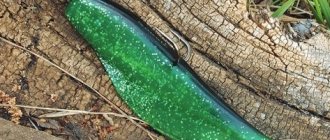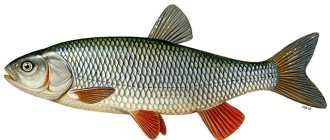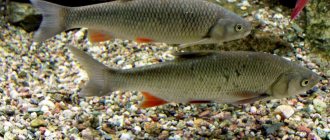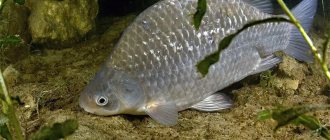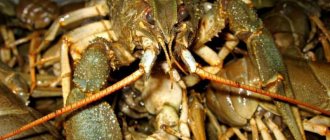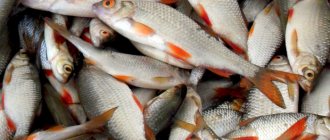Choosing tackle for chub
Catching chub on a crust of bread suggests that the installation of gear should begin with the choice of a fishing rod. For this type of fishing, a light spinning rod or a medium-length match rod would be preferable. Although a simple five-meter float fishing rod will do.
The rules are:
- You should choose a medium-sized hook. A hook of size 4-5 according to the international classification is quite suitable.
- It is advisable that the hook be made of thin wire.
- The hook should not stick out much from the nozzle.
- A monofilament line with a diameter of about 0.25 mm is suitable as a base.
- A float is not used in this type of fishing.
Some fishermen, when catching chub on a crust of bread, use a neutrally weighted float for long-distance casting when installing gear. Many people also know it as bombarda or sbirulino.
Seasonal preferences of chub
The influence of the season on the taste preferences of the chub is more pronounced compared to other species of fish. The universal rule, according to which bait of animal origin is more effective in spring and autumn, and bait of plant origin in summer, also works well for chub.
Spring
After the ice melts, warm shallow waters are promising places for fishing. Chub activity increases as the water warms up and reaches its maximum at the end of May. The fish prepares for spawning by feeding heavily throughout the mating season.
Undoubtedly, the most favorite bait is the cockchafer. As soon as the opportunity arises to catch it, you must do it immediately. It’s not at all difficult to get it; you just need to shake the tree a little and collect the fallen beetles in a box. The flight of cockchafers lasts no more than three weeks, so for fishing at other times it is important to look for a worthy replacement.
Grasshoppers and worms are deservedly considered a good alternative to chub for chub fishing. In the spring, chub readily grab baits made from dough and pellets of bread. He won't refuse a small minnow either.
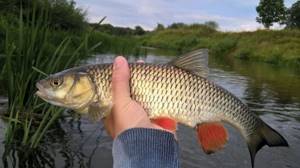
Summer
Summer is the best time to catch chub. It can peck at any time of the day, but maximum activity occurs in the morning and evening dawns.
The extremely catchy spring bait (chafer bug) can be replaced quite painlessly with a variety of caterpillars, as well as grasshoppers.
Traditionally, in hot weather, vegetable baits are preferred for fish. Despite the fact that the chub still responds better to baits of animal origin, in the summer it readily responds to steamed peas, corn and bread.
Autumn
In autumn, chubs become more capricious and sensitive to weather changes and especially pressure changes, when the bite can completely stop and appear only a few days after the pressure has stabilized. As winter approaches, the bites become less and less. With the onset of the first frosts, the activity of the lobasta decreases to zero.
The best autumn baits for chub are caterpillars, maggots, bloodworms, pearl barley, corn, and pieces of meat. The fry of such fish as gudgeon or bleak at this time are a stable bait. To catch a trophy chub, small frogs are hooked onto a hook.
Winter
In winter, chub are caught, but much less often. In warm, frost-free weather with a small layer of ice or its absence, it can be caught with bloodworms, live bait, worms or bark beetles. Raw liver has also proven itself to be excellent for winter fishing for bass. In severe frosts, as well as closer to spring, the smut becomes passive, lying on the bottom. He is practically not interested in feeding, so catching him becomes a futile task.
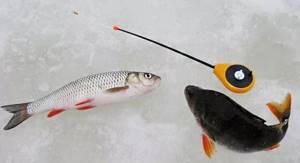
Preparing for fishing
As a nozzle, you should use a piece of bread crust with crumb. You can use black bread or a piece of loaf:
- The crust should be slightly dry. Gradually dissolving in water, the crumb will attract fish.
- The size of the crust should match the size of the hook.
- The hook should be passed through the crust twice - this will hold more securely.
In spring, the chub prefers to feed near the surface. Insects and fish fry falling from branches are his favorite delicacy.
When searching for chub, you should first consider:
- sections of the river with reverse flow;
- riffles, eddies and various whirlpools;
- stretches of river with overhanging tree branches.
Where to look for chub
As its main habitat, it prefers rivers with fast currents, many small riffles, rocky bottoms and cold, clear water. This is a shy and attentive fish, which requires careful camouflage by the fisherman to catch.
Chub are most often caught using a float rod, but some experienced fishermen practice active spinning fishing for this fish.
Chub fishing begins from the moment the ice begins to melt and continues until the first autumn frosts. The bite continues throughout the day, but the best fishing times are early morning and late evening .
It is worth noting that it is at night that adult and large representatives of the species go hunting, which increases the chances of catching a trophy specimen.
Chub are extremely sensitive to weather changes and external pressure, so fishing is successful only on stable days according to meteorological indicators. Moreover, the weather should have been stable for several days in a row before you go fishing.
But the breeze will have a positive effect on fishing; the bighead becomes less careful when light ripples appear on the water, since it practically does not see what is happening above the surface.
The chub tries to stay close to places of rapids and fast currents, as this is the best place for hunting. When the water temperature drops, it goes to deep, calm places. During the summer heat, it prefers to stay under the crowns of trees and other plants hanging over the water or simply in the shade.
It is also worth highlighting the fruit trees hanging over the water, since the chub is half a predator and loves fruits falling from the trees, especially cherries . So, if you know a place where a fruiting cherry tree is bent over the water, feel free to go there for fishing, most likely it has settled there.
Small whirlpools, into which insects that have fallen into the water, will often become a catchy place. The boundaries of slow and fast currents, and especially boulders peeking out of the water, will also become favorite hunting grounds for chub.
In early spring, when the water has not yet warmed up, the chub will stay in the “half water” or closer to the bottom. At this time, the big-headed one is located near small rifts, where it hunts.
With the beginning of summer, when the upper layers of water are already warmed up, the fish rises to the surface, where it collects fallen insects. This feeding will last until the first autumn cold snap, when the lobster will again descend to the depths, from where it can only be retrieved using bottom tackle.
Casting and biting
The cast should be made to the marked place, in the direction opposite to the current.
It’s a good idea to pre-feed the intended location with bait:
- You can use ready-made bait containing cake.
- For a budget option, it is suitable to periodically throw pieces of bread and crusts into the marked place.
After casting, do not lower the handle of the spinning reel. The nozzle should float smoothly with the flow.
You should not use the so-called holding and braking, used when catching roach and other white fish “on a train”. Chub is a very cautious fish. Sometimes you need to swipe the nozzle several times to attack it.
The bite occurs in the form of a sudden disappearance of the crust of bread under water.
You should hook within 2-3 seconds, otherwise you will simply rip the bait out of the fish’s mouth:
- Sometimes, in the feeding area, weak bites of small chub occur first. Then a strong blow from the older brothers may follow.
- You should strive to get the fish ashore as soon as possible, unless, of course, it is a small specimen.
- A trophy chub should be fished out slowly, having first tired it out.
- For quicker fishing, you should always use a landing net.
- After catching a large specimen, you need to change the fishing location.
As with any other fishing, you should not make noise or talk too much, otherwise you risk scaring the fish.
Bread is the king of plant-based toppings. How to fish with bread: crust and crumb
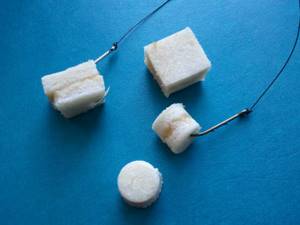
The question arises, why bread? But what about the vaunted bloodworms and maggots? But now we will talk about attachments of plant origin (namely bread).
It is plant foods that fish prefer in the warm season. And secondly, bloodworms and maggots are not always and not always available for sale, and prices are constantly rising... Growing, for example, maggots at home is not easy, and not always possible. In addition, live bait requires special storage conditions.
Of course, mosquito larvae and flies are attractive to fish. I don’t want to say that some are better and some are worse, but let’s return to the “bread topic” and consider the advantages of bread as a topping:
- Catchability. Bread is an attractive food for most peaceful fish.
- Availability. Bread can be purchased at any retail outlet at an affordable price, or baked at home.
- There are many recipes for making bread toppings.
- Fishing with bread bait does not require delicacy of bait.
- The bread holds up well on the hook.
- Versatility. You can fish with bread using float, feeder, bottom tackle, etc.
The opinion that only dummies fish for bread, and that they do not properly prepare for fishing, is incorrect.
Bread is really the most accessible and cheapest attachment.
I would like to give a few recipes for making nozzles with a bread base:
- Knead the bread crumb with your hands until a homogeneous mass is formed. You can add sunflower oil, vanillin, honey, cinnamon, oatmeal... It’s a good idea to make such a bait with a good attractant, etc.;
- Bread is kneaded with boiled potatoes. Additives - to your taste. It should be added that in terms of attractants, bread is universal, because it absorbs them well and goes well with them.
- The crumb of white bread is kneaded with a raw egg and boiled in boiling water over low heat until the mass darkens.
- The bread is kneaded with steamed cake. Well, everything is clear here. Some also advise adding crushed coal.
- The bread is kneaded with melted cheese.
- You can mix bread with dough (paste), Mastyrka, fishing mixtures, sold in stores, and already flavored. You can even mix bread with different types of semolina.
Let's take half a loaf. Cut it into two parts, apply any attractant to one, put it together, and put it in the freezer. When defrosted, the bread will absorb aroma and attractants.
The above recipes for bread attachments are basic and well-known. The field for experiments with bread is large.
Garlic can be used as an affordable and good flavoring agent. Not only roach and crucian carp, but also bream, tench, and silver bream bite on bread flavored with garlic juice. There are many articles where the authors say that the smell of garlic is not attractive to bream. But my experience indicates the opposite - in the summer of 2009. (The period of my experiments with bread) several white bream up to 500g were caught on bread with garlic. Other attachments were ignored.
In the near future I want to experiment by mixing bread with semolina and dip, or adding the latter before casting.
When fishing with bread, as with any soft bait, you need to hook in time.
A few words about bait.
It’s clear that when we fish for bread and feed with Sensas, there will be no result. We use crackers, cake, etc. You should also remember: with great competition, with strong fishing pressure, fishing with bread with appropriate bait is unlikely to give great results. But the heron fundamentally disagrees with this - “the main thing is to choose the right bait!” 

And of course. How could I forget about the bread crust? Back in the day, L.P. Sabaneev wrote about fishing for carp using a crust of black bread (the tackle was a strong rod with a blind rig, with a thick line and a large hook.) The fishing was done from reeds using a floating bait. I don’t think this method has completely lost its relevance. It’s just that the method requires modern refinement. And about this another time.
No tail, no scales!
Thank you for fishing with us! Or not yet? Yandex.Zen Facebook
Tags
of silver bream how to catch crucian carp bream tench roach bread
Some fishing tips
Over time, one comes to understand some of the subtleties of this type of fishing that are incomprehensible to beginners.
Here are a few of them:
- Try to position yourself so that the sun is behind you.
- If you live close to the body of water where you fish, take the time to bait several places. If you come and feed certain places during the week, you will probably not be left without a trophy.
Do not despair if on your first fishing trip you are left without a catch. Next time you will definitely be lucky.

